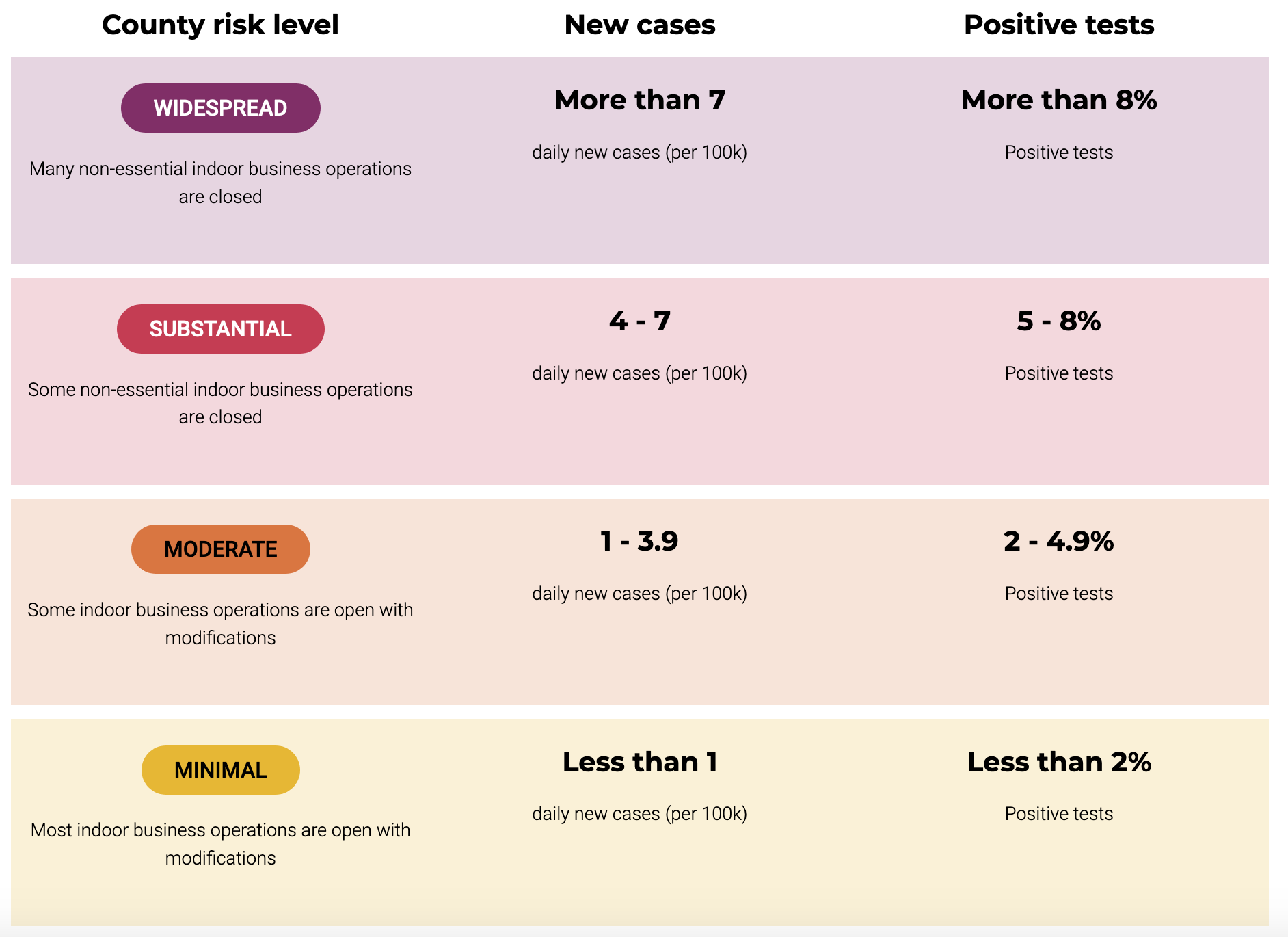Decoding a color-coded reopening
Say goodbye to watch lists and welcome the official color palette of COVID-19 reopening. The Newsom administration released their “Blueprint for a Safer Economy” last week along with an online tool and a map covered in purple.
The new health guidance is based on a 4-tier framework designed to make it easier to understand the health status of your county. It’s still complicated, but reopening was never going to be simple.
Questions and Answers
What tier are Alameda and Contra Costa County?
Along with most of California, the East Bay is in the “widespread” or purple-colored tier. That means many non-essential indoor businesses will remain closed.
However, as of August 31 counties in this most restrictive tier may still open all retail, shopping centers at 25% capacity, and indoor hair salons with modifications. Whether reopening will prove financially viable for those businesses is another question.
How often are tiers updated?
Starting with the first weekly update set to be released on September 8, counties will stay at their tier for a minimum of 21 days. Moving into less restrictive tiers will be based on the number of new positive cases per 100,000 population and the percentage of positive test results over the previous week.
Right now both East Bay counties are in the red tier for positive test rate but purple for case rate. As long as the case rate remains high, the region will remain in the purple.
What about in-person school?
Schools can only reopen for in-person instruction once a county has stayed in the red tier for at least two weeks. In the East Bay, that means that the earliest in-person instruction could be considered for return by local districts and governing boards is early-October.
Can counties set stricter guidelines than the state?
Yes. The state guidelines are a minimum threshold.
Where is the green tier!?
Until there is an effective vaccine broadly available, state leaders want to ensure there is not an expectation of complete reopening.
"We don't believe that there is a green light, which says go back to the way things were or back to the pre-pandemic mindset," said Governor Newsom.
Nominate inspiring community leaders
Now is the time to submit a nomination for the 10th Annual Philanthropy Awards.
Our region and society have been tested in unprecedented ways in just a few short months. Your nomination will help us tell the stories of inspiring community leaders, philanthropists, employers, volunteers and youth who are stepping up for our community in a time of profound need.
Thank you to our Philanthropy Awards sponsors for making this inspiring and important event possible
Must read // Now it's up to Governor Newsom
Laurel Rosenhall in CalMatters: In a year when the coronavirus pandemic upended every aspect of normal life, the impact in the California Capitol was also dramatic. Lawmakers took an unprecedented two-month pause in the spring, when Gov. Gavin Newsom issued a statewide order for people to stay home to prevent the spread of the virus.
They returned to the Capitol in May, passed a state budget shrunken by the pandemic-induced recession, and began setting aside hundreds of bills that would no longer make the cut in this truncated year. Faced with less time to hold hearings and less money to spend on new initiatives, lawmakers chucked an estimated three-quarters of the bills introduced at the beginning of the year.
Abandoned or rejected along the way were bills requiring police to intervene if they see officers using excessive force, allow homeowners to request a forbearance on their mortgages during the pandemic, and launch a “Green New Deal” to fight climate change.
But even with their reduced workload, lawmakers tackled numerous thorny issues, passing legislation that could impact life in California for years to come — to allow more workers to take paid family leave, make it easier to get mental health care, and ban flavored tobacco, among others.
Now it’s up to the governor to decide if their ideas should become law. Below are some of the most interesting decisions he faces.




